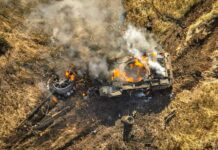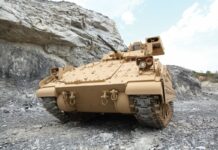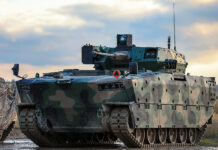An increasing number of countries in Europe have now purchased new fleets of wheeled Armoured Fighting Vehicles (AFV) in the 8×8 configuration.
In some cases, these have replaced tracked AFV while other countries have deployed a mix of tracked and wheeled AFVs. When compared to their tracked counterparts, wheeled AFV have a number of advantages including lower life cycle costs and greater strategic mobility as tracked AFV normally have to be transported over long distances by heavy equipment transporters (HET). But they do have a higher ground pressure than their tracked counterparts. It is worth remembering that Russia and other members of the now defunct Warsaw Pact always deployed a mix of tracked and wheeled APC/IFV and this trend has continued.
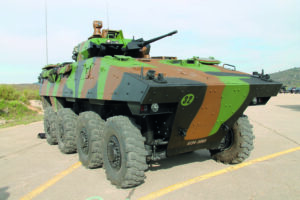
While most of the recently introduced 8×8 have been in the armoured personnel carrier (APC) configuration, there is also a trend to deploy these in the Infantry Fighting Vehicle (IFV) role which are normally armed with a one or two person turret armed with a medium calibre cannon or a Remote Weapon Station (RWS) or remote controlled turret (RCT) also armed with a medium calibre cannon.
In addition to being used as an APC or IFV, 8×8 vehicles are also being used for an increasing number of more specialised roles such as ambulances, command post vehicles, mortar carriers and engineer vehicles. Some European AFV contractors have supplied 8×8 not only to their own armed forces but also achieved major export sales to other countries, with some also undertaking local manufacture with the platform optimised to meet their own specific requirements. This especially applies in the key areas of survivability and firepower. Most 8×8 today have a base line hull, normally of all welded steel, to which a Modular Armour Package (MAP) can be fitted with increased protection against mines and Improvised Explosive Devices (IED). There are clearly, however, limits to the amount of armour that any AFV can carry before its mobility is limited.
Operational experience has also shown that, as well as having an NBC system, the platform must have a climate control system to allow it to be deployed in areas with a high ambient temperature. In addition, todays vehicles have an electronic architecture enabling easier upgrades on the future. The increasing number of sub-systems that require electric power, such as RWS, Battle Management Systems (BMS), Environmental Control Systems, cameras and in some cases electronic devices to counter IEDs, have driven up the requirement for increased electric power for the platform. Command post vehicles, for example, can have an Auxiliary Power Unit (APU) allowing all of their communications equipment to be run with the main engine switched off to save fuel.
The size and weight of 8×8 AFVs have been increasing as the end user wants more volume, payload and protection. Most customers select the BMS, communications equipment and weapon fit. The latter can be Government Furnished Equipment (GFE) and, in addition to being used for the 8×8, can also be fitted to other platforms with the obvious logistic and training advantages.
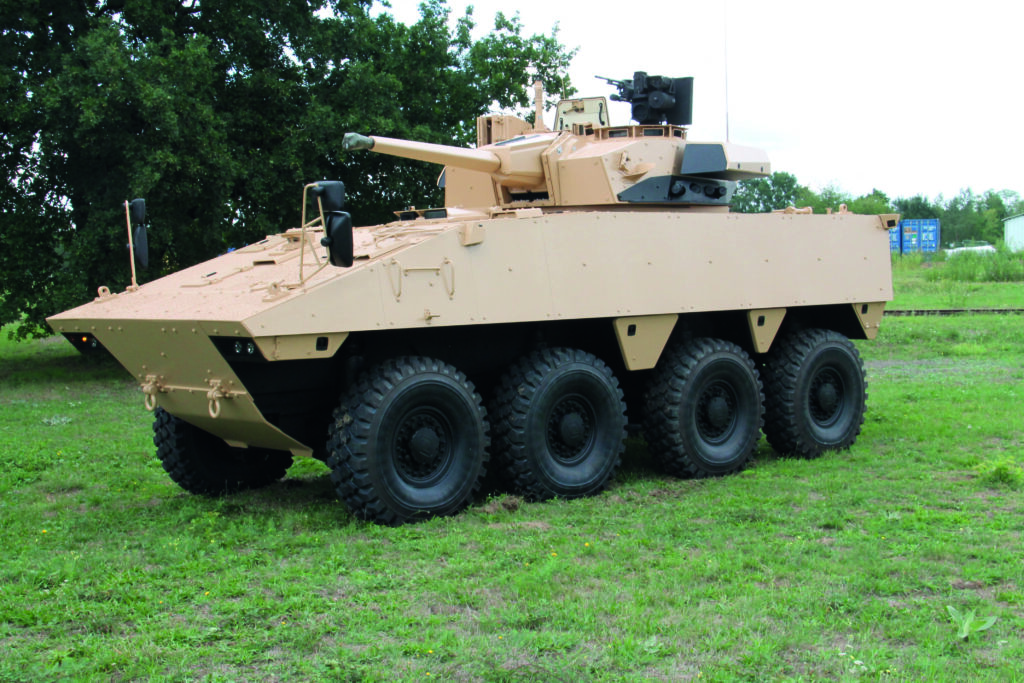
When being used as an APC, 8×8 have typically been fitted with a Protected Weapon Station (PWS) or a RWS armed with a machine gun (MG). The trend is now to fit larger calibre weapons. Most contractors today offer the end-user considerable flexibility as to regarding interior arrangement, seating, roof hatches and and/or ramp or door/doors at the rear to allow for rapid entry and exit of the dismounts. Traditional bench type seats have now given way to special blast-attenuating seats for all dismounts which are fitted with a five point harness for increased crew survivability. There is also flexibility as regards to the powerpack, with Caterpillar, Cummins and Scania being the most popular diesel engines and Allison and ZF for the automatic transmission.
While most 8×8 have powered steering on the front four wheels, two either side, some contractors also offer powered steering on the last road wheels which gives a reduction in turning circle which is useful when operating in an urban environment.
The ability to move across terrain is a key requirement for all military platforms, especially 8×8, and many platforms have a Central Tyre Inflation System (CTIS) allowing the driver to adjust the tyre pressure to suit the terrain being crossed. Some also offer the suspension with a height adjustment capability.
In the past, one of the requirements has been for the 8×8 vehicle to have a fully amphibious capability but in most countries this requirement has now lapsed, although the earlier Russian BTR-60/BTR-70/BTR-80/BTR-82 and latest Russian BUMERANG (8×8) retain an amphibious capability.
The first LAV-25 fielded by the US Marine Corps over 35 years ago, had a typical gross vehicle weight (GVW) of around 13 tonnes which compares with the latest PIRANHA 5 which has a GVW of up to 30,000 kg of which up to 14,000 kg is the payload.
While some countries purchase the baseline platform off the shelf and then modify it to meet their own specific requirements, other prefer to manufacture the baseline vehicle under licence to maintain local jobs and the potential transfer of technology. For some contractors, including Patria of Finland (Armoured Modular Vehicle), General Dynamics European Land Systems – MOWAG of Switzerland (Piranha) and FNSS Savunma Sistemleri of Turkey (Pars), more 8×8 have been exported than sold to the home market.
Austria
The Austrian company of Steyr-Daimler-Puch (today General Dynamics European Land Systems – Steyr) (GDELS) developed the PANDUR (6×6) APC which was adopted by the Austrian Army as well as some export customers including Belgium, Kuwait, Slovenia and the US. Further development resulted in the PANDUR II (8×8) which has been sold to Czech Republic and Portugal who undertook local production/assembly. More recently, Indonesia has ordered 23 PANDUR II (8×8) through Excalibur of the Czech Republic as GDELS – MOWAG concentrates its main export effort on PIRANHA 5 (8×8).

The General Dynamics European Land Systems – MOWAG PIRANHA 5 has now been adopted by Denmark, Romania and Spain and can be used for a wide range of missions such as an engineer vehicle shown here. (Photo: GDELS)
Finland
In close co-operation with the Finnish Army, Patria developed the Armoured Modular Vehicle (AMV) (8×8) as a follow-on to their highly successful XA series of 6×6 vehicles of which over 1,100 were built for the home and export markets. In close co-operation with the Finnish Army, Patria developed the Armoured Modular Vehicle (AMV) with more internal volume and greater payload than the earlier XA (6×6) series and can undertake a wider range of battlefield missions.
The Finnish Army has taken delivery of the AMV in the APC role fitted with a Kongsberg PROTECTOR RWS armed with a stabilised 12.7mm MG plus 18 fitted with the Patria twin 120mm AMOS (Advanced Mortar System). AMV has been a major success on the export market, with sales being made to Croatia, Poland (local production as the ROSOMAK), Slovenia (SVARUN), South Africa (delayed local production as the BADGER), Sweden and the United Arab Emirates (UAE). The procurement of 81 AMV (8×8) for Slovakia has been delayed. This is known as the VYDRA and is fitted with a locally designed TURRA turret armed with a Russian 30mm 2A42 dual feed cannon and 7.62mm co-axial MG.
The UAE took delivery of five AMV in the 8x8L amphibious version from the Finnish production line which were fitted in the UAE with the complete turret of the Russian BMP-3 IFV which is used in large numbers by the UAE. Since then, additional AMV have been supplied from the Polish production line to the UAE and these were fitted with their weapons on delivery. As well as being used as an APC, the AMV is used as a IFV with Poland, for example, deploying a version with a locally manufactured Leonardo turret armed with a Northrop Grumman 30mm MK44 dual feed cannon and 7.62mm co-axial MG.
In response to customer’s requirements Patria has, using internal research and development funding, developed the PATRIA AMV XP which stands for extra performance, extra payload, protection. The original AMV had a GVW of around 27 tonnes while the latest AMV XP has a GVW of 32 tonnes of which up to 15 tonnes is payload which includes the armour package, weapon system, ammunition and crew. Development of the AMV XP is complete and it is expected that future customers would opt for this version while existing customers would stay with the standard AMV.
Patria has completed development of the latest Armoured Wheeled Vehicle (AWV) 6×6 vehicle which was launched in 2018 enabling the company to offer potential customers an 8×8 or a 6×6 vehicle. PATRIA AWV 6×6 uses components from the AMV XP and has recently been selected as a joint programme by Estonia, Finland and Latvia to replace their currently deployed PATRA XA series of vehicles.
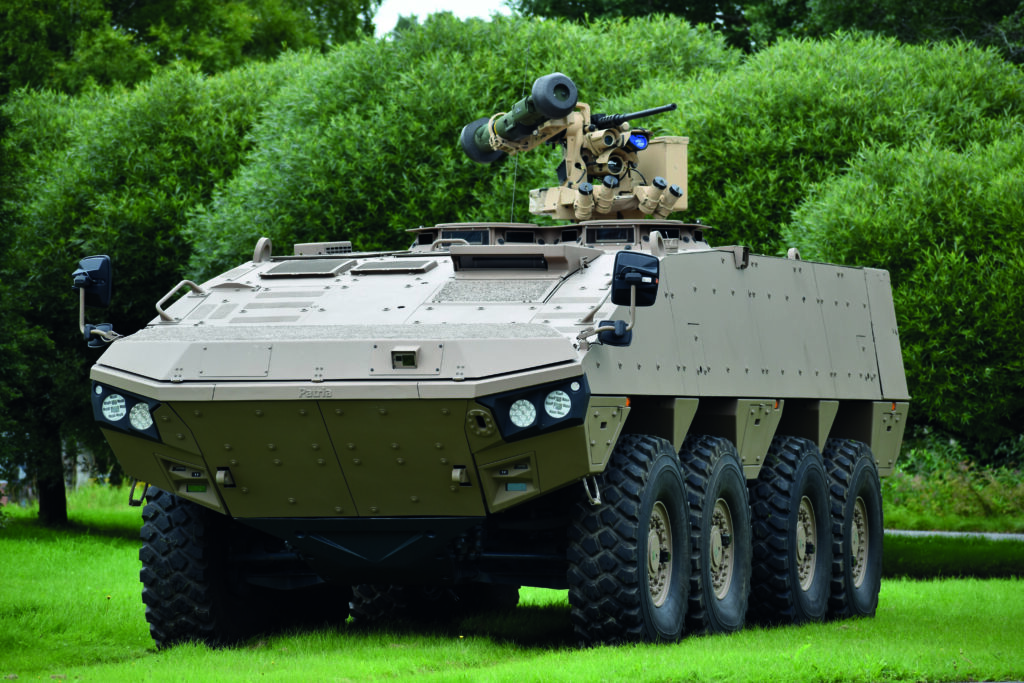
France
The French Army has now replaced its feet of tracked AMX-10P IFV with the Nexter VBCI (8×8), with 630 of these completed at their Roanne facility. Of these, 520 were in the IFV configuration and remaining 110 on the command post (CP) role fitted with a RWS armed with a 12.7mm MG. The IFV has a Nexter one-person turret armed with a 25mm M811 dual feed cannon and a 7.62mm MG that can be laid onto the target by the gunner, seated in the turret, or the commander seated in the hull to the rear of the driver on the left side.
For the export market, the VBCI has been demonstrated fitted with the Nexter T40 turret armed with a 40mm Case Telescoped Armament System (CTAS), 7.62mm co-axial MG and the option of an anti-tank guided weapon (ATGW) mounted either side of the turret. This was originally called the VBCI-2 but this designation has been dropped. Qatar signed a letter of intent for 490 VBCI in December 2017 but this has yet to be confirmed. While the VBCI production line is currently closed, it has been used to upgrade earlier vehicles to a GVW of 32 tonnes.
International
Collaborative AFV programmes have often fallen by the wayside but after some delays one of the major success stories has been the ARTEC BOXER (8×8) Multi-Role Armoured Vehicle (MRAV) which has now been adopted by Australia, Germany, Lithuania, Netherlands and, most recently, by the UK who was one of the original members. The UK placed its order with ARTEC for just over 500 units with production to be undertaken in the UK by Rheinmetall BAE Systems Land (RBSL) and Williams Fairey Engineering Limited (WFEL).
The original mission of the BOXER was typically an APC with the German models fitted with a Krauss-Maffei Wegmann FLW 200 RWS armed with a 12.7mm MG while the Netherlands BOXER are fitted with a Norwegian Kongsberg RWS also armed with a similar weapon. The Lithuanian BOXER are in the IFV role and fitted with a RAFAEL Advanced Defense Systems Sampson Mk II RWS armed with 30mm dual feed cannon, 7.62mm co-axial MG and ATGW.
For Australia, the BOXER will replace its currently deployed General Dynamics Land Systems Light Armoured Vehicle (LAV) (8×8) used in the reconnaissance role. Australian BOXER will be fitted with the latest Rheinmetall LANCE turret armed with a Mauser 30mm MK 30-2 dual feed cannon and 7.62mm co-axial MG coupled to a computerised FCS.
The detachable rear mission module enables the BOXER to be rapidly re-rolled for different battlefield missions and for trials purposes it has been fitted with the Krauss-Maffei Wegmann 155mm/52 calibre Artillery Gun Module (AGM). Other trials versions include being fitted with a Rheinmetall Air Defence Oerlikon SKYRANGER 35mm air defence system and a roof-mounted laser air defence system. At DSEi held in London in September 2019, the German company of FFG launched their private venture recovery module installed on a BOXER.
BOXER has a typical GVW of around 36.5 tonnes but the UK BOXER, for example, will have a GVW of up to 38.5 tonnes as well as having a 600 kW engine.
Italy
The Italian Army were the first in NATO to realise the potential of wheeled 8×8 vehicles and took delivery of 400 CENTAURO 1 105mm mobile gun systems (MGS), with Spain taking delivery of 84 units. As a result of downsizing of the Italian Army some of these have been passed onto Jordan.
The CENTAURO 1 MGS was developed by an Italian consortium COI which includes Leonardo (previously Oto Melara) and Iveco Defence Vehicles who are responsible for almost all of the tracked and wheeled AFVs deployed by the Italian Army with the exception of the Light Multirole Vehicle (LMV) which is the sole responsibility of Iveco Defence Vehicles and has been built in large numbers for the home and export markets.
These CENTAURO will eventually be replaced by the latest CENTAURO II armed with a turret mounted 120mm smooth bore gun and many other improvements. COI developed the FRECCIA (8×8) IFV to meet the requirements of the Italian Army; it is fitted with a two-person Leonardo HITFIST turret armed with a Rheinmetall Air Defence, Oerlikon 25 mm KBA dual feed canon and 7.62mm co-axial MG.
More specialised versions of the FRECCIA include an ambulance, command post, 120mm mortar and reconnaissance. A recovery vehicle has been designed and built, and this was sold to Spain to support their CENTAURO 1 (8×8) MGS. The first four batches of FRECCIA covered supply of 249 units for one brigade and since then another 30 have been delivered. Currently in production are another 30 under a contract signed late in 2019, with another contract for 11 due to be signed.
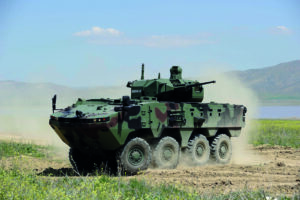
For the export market, Iveco Defence Vehicles developed the SUPERAV (8×8) which is fully amphibious and, when fitted with a Leonardo OWS, is referred to as the Veicolo Blindato Anfibio (VBA). Further development of this with BAE Systems in the USA resulted in this vehicle winning the US Marine Corps Competition for the Marine Personnel Carrier (MPC) which is now in production in the USA.
Serbia
Serbia has now re-established its capability in the design, development and production of a wide range of land systems with particular emphasis on wheeled AFV and artillery Systems.
The locally developed LAZER (8×8) is being marketed by Yugoimport as a Multi-Role Armoured Combat Vehicle (MRACV), with the latest version being the LAZAR II being marketed with a wide range of weapons systems ranging from a 12.7mm RWS up to a two-person turret armed with a 30mm cannon and a 7.62mm co-axial MG and with a GVW of up to 28 tonnes.
The latest LAZAR has a new hull design with applique armour claimed to have a high level of protection against mines and IED. In addition to its crew of three, it can also carry up to 10 dismounts. These are seated in the rear on blast-attenuating seats facing outwards and are provided with firing ports and associated bullet/splinter proof windows.
Switzerland
While Switzerland is not a member of NATO, the now GDELS – MOWAG developed the PIRANHA family of wheeled AFV with the 6×6 version being the first to enter service. Sales were made to Switzerland and Canada with the latter country selecting it to meet its requirement for an Armoured Vehicle General Purpose (AVGP) and with production being undertaken in Canada by the then Diesel Division GMC which became General Dynamics Land Systems – Canada.
In its 8×8 configuration, the PIRANHA is the most widely deployed vehicle of its type in the West and, in addition to being manufactured in Switzerland, is also made in Canada and the US with the US Army version being called the STRYKER. GKN (today RBSL) manufactured the PIRANHA (8×8) under licence for the export market with sales made to Oman and the Kingdom of Saudi Arabia (KOSA).
Development of the PIRANHA has been continuous with the latest model being PIRANHA 5 which has more volume and payload and can be fitted with an armour package optimised to meet the end users requirements. The first customer was Denmark who is taking delivery of 309 units in various configurations to replace its upgraded M113 series of tracked APC and variants. The second customer is Romania where local production is now under way with up to 227 to be delivered to replace older locally manufactured TAB (8×8) APC. The latest customer is Spain who is to take delivery of an initial batch of 348 PIRANHA 5 being supplied by a consortium consisting of GDELS – Santa Barbara Sistemas, Indra Sistemas, Escribano Mechanical & Engineering and Sapa Placenia to meet the Spanish Army requirement for the Vehiculo de Combate sobre Ruedas (VCR) Wheeled Combat Vehicle, or DRAGON.
The first five prototypes have been completed. Final integration will be undertaken at the GDELS-SBS facility in Seville, with first production deliveries due in 2022 to start to replace the currently deployed BMR-600 (6×6) which were first fielded as far back as 1979/1980, but have been upgraded since then.
 Turkey
Turkey
The Turkish Army always preferred tracked vehicles although their Gendarmerie has used quantities of Russian BTR-80 (8×8) with some of these upgraded by Aselsan. While the Turkish company of FNSS Savunma Sistemleri are well known for their expanding series of tracked armoured fighting vehicles they are now a key player in wheeled AFVs.
The first customer for their PARS (8×8) family was Malaysia who ordered 257 units with first vehicles from the Turkish production line followed by local production in Malaysia, with some key sub-systems such as powerpack and drive line coming from Turkey. The second customer was Oman; it is taking delivery of a total of 172 of the latest PARS III on 13 different versions and of these 145 are 8×8 and 27 are 6×6. The IFV version of the PARS III (8×8) is fitted with the latest FNSS SABER 25 one-person turret armed with a Northrop Grumman 25mm M242 dual feed cannon and 7.62mm co-axial MG. The latest PARS III customer is the Turkish Land Forces Command (TLFC) who finally placed their contract in 2019 covering delivery of 100 units in 8×8 and 6×6 models which will incorporate locally produced sub-systems such as engine and transmission.

The Turkish company Otokar has developed a wide range of wheeled AFV and using internal research and funding developed the ARMA in both 6×6 and 8×8 configurations, which share many common components to reduce costs. While not adopted by Turkey, the ARMA has been sold overseas, with Bahrain being the launch customer for the 6×6 model.
Further development of the ARMA (8×8) resulted in the RABDAN (8×8) for the UAE with a first contract for 100 units. They are fitted with the complete turret of the Russian BMP-3 IFV armed with a 100mm gun, a 30mm coaxial cannon and a coaxial MG.
Ukraine
Before the breakup of the Soviet Union, the now independent Ukraine was a key player in the production of the diesel-powered T-80UD main battle tank (MBT). Today, the Ukraine has expanded its capability to design and produce not only MBTs but also a complete series of wheeled AFVs, including the BTR-4 (8×8) which is very similar to the German Rheinmetall MAN Military Vehicles FUCHS 1 (6×6) with the commander and driver at the front, power pack to their immediate rear with the troop compartment extending to the rear.

The typical GVW of the BTR-4 is around 20 tonnes. It can be fitted with wide range of weapon systems, including a locally developed RWS armed with a 30mm cannon, a 7.62mm co-axial MG and the locally developed BAR’ER ATGW. As well as being deployed by the Ukraine, export sales have been made to a number of countries.
The earlier GUARDIAN BTR-3U (8×8) manufactured in the Ukraine for the export market is essentially a Russian BTR-80 (8×8) but with a higher roofline to the rear of the commander`s and driver`s position at the front of the vehicle. This provides greater internal volume and allows the turret to be fitted with a deeper turret basket.
Christopher F. Foss has been writing on armoured fighting vehicles and artillery systems since 1970. He has also lectured on these subjects in many countries as well as chairing conferences all over the world. He has also driven over 50 tracked and wheeled AFVs.




